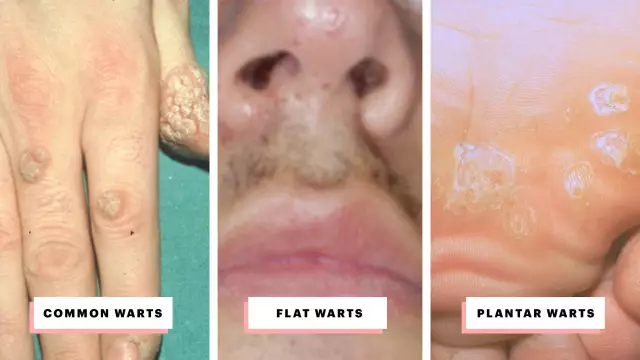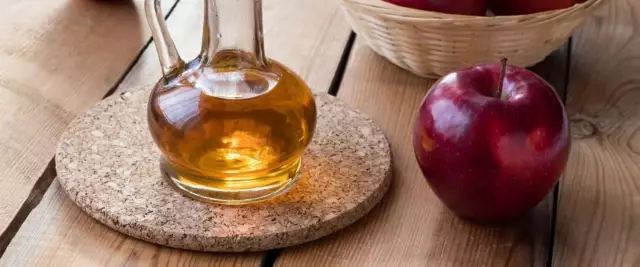- Author Rachel Wainwright [email protected].
- Public 2023-12-15 07:39.
- Last modified 2025-11-02 20:14.
How to use celandine for warts correctly
The content of the article:
-
Celandine like a plant
Chemical composition
-
How to use celandine
- Milky juice
- Tincture
- Oil
- Decoction
- Rules for the collection and preparation of medicinal raw materials
- Reviews
- Contraindications
- Side effects and disadvantages
-
Pharmacy preparations
Instructions for use
- Are all pharmacy products the same
- Celandine vs modern ways to remove warts
- Causes of warts
- Video
Celandine (swallow grass, warthog, Chelidonium majus) is a medicinal plant that is successfully used in folk medicine to treat a number of different pathologies. In this article, we will talk about how to use celandine for warts correctly.
Celandine like a plant
Celandine is a herbaceous perennial plant belonging to the poppy family. The people call him cleanliness, cleanliness, warthog. The plant blooms from early May to mid-autumn. Inside contains a milky juice of a bright yellow color. All parts of celandine are poisonous.
In the European part of Russia, this plant grows like a weed in city parks, along roadsides, in forest glades and summer cottages. Celandine was introduced to the United States in 1672 and has since been cultivated there as a plant that helps get rid of viral warts.

One of the names for celandine is warthog, due to its high anti-beard efficacy
Chemical composition
The main active ingredients of celandine are:
- alkaloids;
- vitamin C;
- carotenoids;
- bitterness;
- resinous substances;
- essential oils;
- flavonoids;
- organic acids;
- saponins.
The plant contains over 20 alkaloids - nitrogen-containing substances with a complex composition, with a strong specific effect. It is the alkaloids that make celandine poisonous. But at the same time, thanks to them, it has antiviral, antifungal, anti-inflammatory, antiseptic and cauterizing properties.
How to use celandine
Before carrying out the procedure for removing warts, any fatty ointment or petroleum jelly is applied to the healthy skin around the neoplasm. This helps to protect it from possible burns or irritation. The surface of the growth is moistened with warm water and lightly scrubbed with a sterile scalpel. Only after all these conditions are met, a herbal remedy can be smeared on it.
Milky juice
Milky juice of freshly cut grass is applied to the surface of the papilloma several times a day. Cauterization is carried out for 10-15 days - the duration of the course depends on the severity of the disease, the duration of the existence of neoplasms and their location.
Tincture
Rinse the herb of the plant, cut it and place it in a dark glass jar, filling it 2/3 of its volume. Pour 70 ° ethyl alcohol to the top. Insist at room temperature for 21 days, shaking occasionally. Strain.
Apply the resulting tincture to the problem area 1-2 drops several times a day. When treating plantar warts, compresses with tincture are applied to them for 20 minutes.
The course of treatment should not exceed 30 days.
Oil
Chopped leaves of celandine are poured into a jar, filling it to the top. Pour in olive or sunflower oil. Insist on sunlight, mixing thoroughly 3-4 times a day for 15 days. They are filtering.
The resulting oil is used to apply compresses to problem areas of the skin, which should be replaced every 12 hours. The duration of this method of burning out warts is 7-14 days.
Decoction
Some herbalists argue that in order to remove papillomas as quickly and efficiently as possible, it is necessary to combine the external use of celandine preparations with the intake of a decoction of this plant inside. However, this method of treatment is not recommended, since it is associated with a high risk of poisoning, requiring immediate medical attention to the patient. That is why we do not give a recipe for the preparation of a decoction of celandine, intended for oral administration, and we strongly advise against using it.
Rules for the collection and preparation of medicinal raw materials
Celandine should be harvested during the summer months, during its maximum flowering period. Plants growing along major highways or near large production facilities should not be harvested.
When collecting, preference should be given to plants with bright green foliage that do not have any mechanical damage or signs of disease.
Reviews
Numerous reviews of both patients and medical practitioners confirm that celandine provides a fairly quick getting rid of warts. When used correctly, the growth should turn black and dry. After the scab falls off, there is usually no pigmentation or scars left on the body. In cases where it is necessary to remove very large papillomas, scar tissue may appear in their place.
Contraindications
Cauterizing warts with celandine is contraindicated if the patient has the following diseases:
- unstable angina;
- bronchial asthma;
- pregnancy and the period of breastfeeding;
- epilepsy;
- increased individual sensitivity.
It is possible to use warthog herb for the treatment of children only as directed by a doctor and with great care. You should not apply milky juice, tincture or oil to papillomas located on the baby's face, as in this case a deep chemical burn may occur, which will lead to the formation of a rough scar.
Side effects and disadvantages
The main disadvantages of home therapy for viral papillomas with warthog herb preparations are:
- soreness of the procedure;
- long-term wound healing;
- the risk of joining a purulent infection;
- the likelihood of the formation of rough scars, especially when removing large neoplasms;
- impossibility of accurate dosing.
Side effects of treatment include burns to healthy skin around the papilloma.
If the therapy is not carried out correctly, the papillomas are not removed, but only their injury. Over time, this can lead to malignancy of the neoplasm, i.e., its transformation into a malignant tumor.
Pharmacy preparations
If you do not have time to collect herbs and prepare phytopreparations on its basis, you can purchase ready-made dosage forms at the pharmacy. These drugs include oil, balm, ointment and liquid celandine extract.
Warts should be burned out with their help with great care, since they contain a high concentration of the active substance. Avoid contact with warthog preparations in the eyes and mucous membranes, so as not to cause injury.
Instructions for use
Remove papillomas using pharmacy products as follows:
- wash the skin thoroughly in the problem area;
- lubricate the skin with petroleum jelly around the papilloma;
- using a cotton swab to take a small amount of the drug and gently apply it to the surface of the papilloma.
The application of the medicine must be repeated 2-3 times a day for 5-15 days. To enhance the effect, you can first steam the area of the skin on which the viral warts are located.
Pharmacy products based on warthog herb should not be used when localizing epidermal growths on the face, neck, décolleté and mucous membranes.
Are all pharmacy products the same
When purchasing drugs for removing warts at the pharmacy, carefully study their composition. For example, in the pharmacy chain you can often find such medicines as SuperCleaner or SuperCleaner. Despite their name, they have nothing to do with celandine and do not contain the extract of this plant. A small bottle contains an alkali solution and cosmetic additives. Naturally, one cannot expect the same effect from their use as from preparations with a natural extract of a medicinal plant.

Despite the name and design of the package, the pharmaceutical preparation "Superchistotelo" does not contain celandine
Celandine vs modern ways to remove warts
Modern medicine offers various ways to get rid of papillomas in a short time. These include:
- laser therapy;
- radio wave therapy;
- cryodestruction (cryotherapy);
- electrocoagulation.
Each of these methods has both advantages and disadvantages. But they all have common positive aspects:
- quick healing effect;
- painlessness of the procedure;
- safety;
- low likelihood of scarring and pigmentation.
Celandine makes it possible to get rid of only small skin growths that do not cause discomfort (itching, burning, pain) to a person.
Before you start trying to get rid of warts on your own, carefully weigh the pros and cons. Remember that they can be of an oncogenic nature and self-medication in this case can do much more harm than good. Only a doctor can find out what exactly a patient has, a benign wart or a malignant epithelial tumor, after a biopsy and a histological examination of the material obtained.
When papillomas appear on the skin or mucous membranes, it is best for the patient to contact a dermatologist for examination and conduct the necessary examination. The doctor will select the most optimal method for removing warts in each case. In addition, he will prescribe antiviral and immunomodulatory therapy, which will allow the patient to fully recover and prevent recurrence of the disease.
Causes of warts
Warts (papillomas) are small, benign growths located on the surface of the skin or mucous membranes. Depending on the location and appearance, the following types of warts are distinguished:
- vulgar (ordinary, simple);
- plantar;
- palmar-plantar;
- anogenital (condylomas).
The disease is widespread and affects people of any age and gender. It is caused by the human papillomavirus (HPV). Sick people and virus carriers are the source of infection. The main routes of infection are:
- contact and household;
- sexual;
- vertical (from mother to child during childbirth).
Factors that increase your risk of contracting HPV include:
- non-compliance with the rules of personal hygiene;
- promiscuous sex life;
- frequent visits to public pools, baths;
- close contact with animals.
The papillomavirus enters the human body through traumatic damage to the skin or mucous membranes. Then it penetrates into epithelial cells, where it can be in an inactive "sleeping" state for a long time. When immunity is weakened, HPV is activated and causes accelerated division of cells in the basal layer of the epithelium, which leads to the formation of papillomas.
The results of numerous studies have proved that human papillomavirus infection has an oncogenic effect on the human body, that is, it contributes to the occurrence of malignant tumors. Therefore, before proceeding with the removal of warts with celandine, it is imperative to consult a dermatologist.
Video
We offer for viewing a video on the topic of the article.

Anna Kozlova Medical journalist About the author
Education: Rostov State Medical University, specialty "General Medicine".
Found a mistake in the text? Select it and press Ctrl + Enter.






